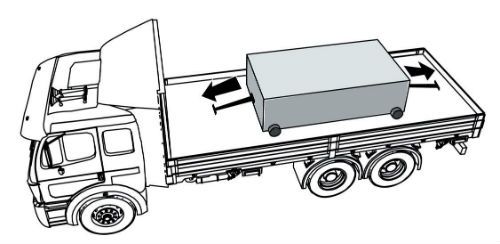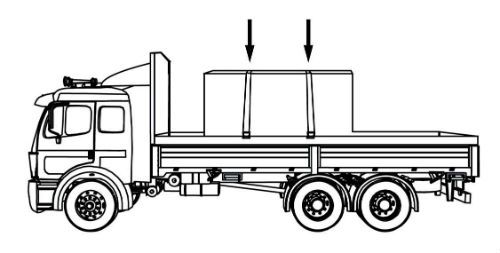CDL Practice Tests: Flatbed Cargo Securement
Choose A Section:
Go!Within the requirements for concrete pipe, which of these requires specific securement methods?
- Concrete pipe eyes vertical and concrete pipe loaded lengthwise.
- Concrete pipe that is grouped together into a single rigid article and may not roll.
- Concrete pipe loaded in a sided vehicle or container.
- Concrete pipe loaded cross-wise on a flatbed trailer.
What is exempt from these specific requirements?
Follow general cargo securement requirements (Section 2) when transporting the following pipe:
- Concrete pipe that is grouped together into a single rigid article and may not roll.
- Concrete pipe loaded in a sided vehicle or container.
- Concrete pipe eyes vertical and concrete pipe loaded lengthwise.
What is covered under these specific requirements?
Any concrete pipe loaded crosswise on a platform trailer or vehicle that is not exempt.
When securing concrete pipe up to 45 inches loaded crosswise, tiedowns through the pipe must be:
- Nylon rope.
- Wire.
- Chains
- Straps.
Tiedown requirements
- Pipe may be secured individually or as a group.
- Tiedowns through the pipe must be chains.
- Front-to-back tiedowns may be chain or wire rope.
The term 'edge protector' refers to:
- A structure, device, or another substantial article placed against an article to prevent it from tipping that may also prevent it from shifting.
- A vertical barrier placed directly behind the cab of a tractor to protect the cab in the event cargo should shift forward.
- A rail along the side of a vehicle that protects the side of the vehicle from impacts.
- A device placed on the exposed edge of an article to distribute tiedown forces over a larger area of cargo than the tiedown itself, to protect the tie-down and/or cargo from damage, and to allow the tiedown to slide freely when being tensioned.
Edge protector:
A device placed on the exposed edge of an article to distribute tiedown forces over a larger area of cargo than the tiedown itself, to protect the tie-down and/or cargo from damage, and to allow the tiedown to slide freely when being tensioned.
A dunnage bag is:
- A structure, device, or another substantial article placed against or around an article to prevent horizontal movement of the article.
- A transverse load bearing structural component, particularly a part of a log bunk.
- A waterproof sheet used to cover cargo.
- An inflatable bag intended to fill otherwise empty space between articles of cargo, or between articles of cargo and the wall of the vehicle.
Dunnage bag:
An inflatable bag intended to fill otherwise empty space between articles of cargo, or between articles of cargo and the wall of the vehicle.
When securing concrete bell pipe in multiple complete tiers, all of the following are true except:
- Bells of the bottom tier must all be on the same side of the vehicle
- Bells of the upper tiers must all be on the opposite side of the vehicle from the bells of the tier below.
- Stack the tiers in pyramid fashion.
- All of these apply.
More than one tier with complete tiers

Bells of the bottom tier must all be on the same side of the vehicle
Bells of the upper tiers must be are on the opposite side of the vehicle from the bells of the tier below.
Specific securement methods are required for boulders that:
- Weigh more than 11,000 lbs, or have a volume of more than 2 cubic meters.
- Weigh more than 5,000 lbs, or have a volume of more than 4 cubic meters.
- Weigh more than 5,000 lbs, or have a volume of more than 1.25 cubic meters.
- Have more than five distinct sides.
The requirements in this section apply to any piece of natural, irregularly shaped rock that:

Weighs more than 5,000 kg (11,000 lb.) or has a volume greater than two cubic meters
Is transported on an open vehicle or in a vehicle whose sides are not designed and rated for the transportation of boulders.
To secure a cubic-shaped boulder, how many tiedowns are required, at minimum?
- 3
- 1
- 2
- 5
Special Circumstances: Securing a Cubic-Shaped Boulder
The securement of a cubic-shaped boulder must meet these requirements in addition to the other large boulder requirements in Section 13.

Secure each boulder individually with at least two chain tiedowns placed side-to-side across the vehicle.
Place tiedowns as closely as possible to the hardwood blocking used to support the boulder.
When securing building materials, how many tiedowns are required for top tier bundles longer than 5 ft?
- 2
- It depends on weight
- 1
- 0
Tiedowns over the top tier of bundles with a minimum of 2 tiedowns over each top bundle longer than 1.52 m (5 ft).
What is the maximum angle recommended for tiedowns securing cement pipe loaded crosswise, relative to the deck?
- 180 degrees
- 45 degrees
- 45-90 degrees
- It doesn't matter
If the first pipe of a group in the top tier is not at the front of the tier beneath:

Attach an additional tiedown that runs rearward at an angle not more than 45 to the horizontal when viewed from the side of the vehicle, whenever practical.
Pass tiedown either through the front pipe of the upper tier or outside the front pipe and over both longitudinal tiedowns.
When using tiedowns to secure boulders, all of the following are requirements except:
- Tiedowns should be located in valleys or notches across the top of the boulder.
- Boulders must be loaded as far back towards the rear as possible.
- Tiedowns must be arranged to prevent sliding across the rock surface.
- Use only chain to secure large boulders.
Requirements

Use only chain to secure large boulders.
Tiedowns in direct contact with the boulder:

Should be located in valleys or notches across the top of the boulder
Must be arranged to prevent sliding across the rock surface.
About The Flatbed Cargo Securement CDL Manual
Studying the flatbed cargo securement CDL manual is not a requirement for getting your CDL permit or license. It is required knowledge for flatbed drivers.
Some questions you should be able to answer for flatbed cargo securement:
- What is the minimum Working Load Limit of a tiedown used to secure logs?
- What is the minimum weight of a shipment of paper rolls that would require specific securement requirements?
- When securing concrete pipe over 45 inches loaded crosswise, which direction must the tiedowns on the front half of the load run?
- What is a cab shield?
- When securing concrete pipe over 45 inches loaded crosswise, which direction must the tiedowns on the rear half of the load run?
- What is a dunnage bag?
- Who is responsible for inspecting securing devices and cargo within the first 50 miles?
- How many tiedowns are required on a stack of shortwood loaded crosswise?
- What is the minimum working load limit of each tiedown used to secure crushed or flattened vehicles?
- Define 'bolster'
- What is a hook-lift container?
- When a tiedown is attached directly to the cargo, what is the ideal angle where it attached to the vehicle?
What is a securing device?
Any device specifically manufactured to attach or secure cargo to a vehicle or trailer:
- Synthetic Webbing
- Chain
- Wire rope
- Manila rope
- Synthetic rope
- Steel strapping
- Clamps and latches
- Blocking
- Front-end structure
- Grab hooks
- Binders
- Shackles
- Winches
- Stake pockets
- D-rings
- Webbing ratchet
- Bracing
- Friction mat
What is a tiedown?
A combination of securing devices that forms an assembly that:
- Attaches cargo to, or restrains cargo on a vehicle.
- Is attached to anchor point(s).

Some tiedowns are attached to the cargo and provide direct resistance to restrain the cargo from movement.

Some tie-downs pass over or through the cargo. They create a downward force that increases the effect of friction between the cargo and the deck. This friction restrains the cargo.
 Related Cargo Securement Terms That Every Driver Should Know:
Related Cargo Securement Terms That Every Driver Should Know:
-
Tiedown:
A combination of securing devices which form an assembly that attaches cargo to, or restrains cargo on, a vehicle or trailer, and is attached to anchor point(s).
-
Contained:
Cargo is contained if it fills a sided vehicle, and every article is in contact with or sufficiently close to a wall or other articles so that it cannot shift or tip if those other articles are also unable to shift or tip.
-
Blocking:
A structure, device, or another substantial article placed against or around an article to prevent horizontal movement of the article.
How should tiedowns be attached?
Tiedowns can be used in two ways:
-
Attached to the cargo:
- Tiedowns attached to the vehicle and attached to the cargo.
- Tiedowns attached to the vehicle, pass through or aroundan article of cargo, and then are attached to the vehicle again.
-
Pass over the cargo:
- Tiedowns attached to the vehicle, passed over the cargo, and then attached to the vehicle again.
Tiedown placement:

Place the tiedown as close as possible to the spacer.
Position the tiedowns as symetrically as possible over the length of the article.

Position the tiedowns to preserve the integrity of the article.







 TT On Facebook
TT On Facebook